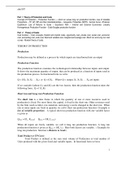Lecture notes
Microeconomics
- Module
- Institution
- Book
Theory of Production and Costs Concept of Production – Production Function –– short run versus long run production function- Law of Variable Proportions – TP, AP, MP and their interrelationships – Isoquants- Properties- MRTS - Isocost Curve –Producer Equilibrium- Law of Returns to ...
[Show more]





